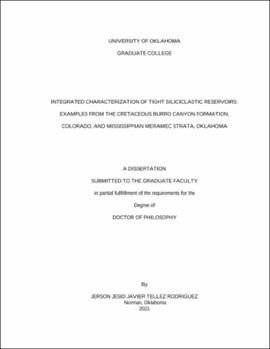| dc.contributor.advisor | Pranter, Matthew | |
| dc.contributor.author | Tellez, Jerson | |
| dc.date.accessioned | 2021-05-14T17:45:40Z | |
| dc.date.available | 2021-05-14T17:45:40Z | |
| dc.date.issued | 2021-05-14 | |
| dc.identifier.uri | https://hdl.handle.net/11244/329575 | |
| dc.description.abstract | Integration of multiscale data sources for reservoir characterization becomes problematic and challenging due to the collected information variable resolution. Core and well data provide high vertical resolution to evaluate stratigraphic variability but fails to assess lateral variability and connectivity. In contrast, outcrop exposures and seismic data are used to extract dimensional statistical measurements and three-dimensional spatial distribution of reservoirs, respectively. It is time-consuming to characterize large outcrops, and rock exposures are often discontinuous. Seismic data offers great horizontal coverage with a low resolution, making it hard to evaluate small lateral variability and spatial distribution of reservoirs. This research explores workflows using new emerging techniques and methods for reservoir characterization such as petrophysics, seismic interpretation, and stratigraphic analysis to effectively address the intrinsic uncertainty in predicting large- and small-scale heterogeneity caused by lateral and vertical facies changes and their petrophysical properties. This detailed characterization reduces the risk associated with exploring and developing potential reservoirs for fluid storage or hydrocarbon production. The applied techniques detailed in this study are used to collect and integrate multiple data sources for reservoir characterization of unconventional reservoirs, mainly fluvial tight sandstones and mixed siliciclastic-calcareous deep marine platform deposits. I present three case studies using workflows that include new techniques for reservoir characterization at different scales. The research starts using UAS (drones) for three-dimensional outcrop reconstruction models for 50 miles of rock exposure combined with fieldwork to define the sequence stratigraphy and architecture of a fluvial reservoir. Then, I present a workflow to integrate information that includes thin-sections, core description, petrophysical data, well logs, and seismic data through machine learning techniques to define the sequence stratigraphic variability and structural configuration of a mixed siliciclastic system. The last case study shows a workflow to predict, map, and analyze the mechanical stratigraphy of the Meramecian STACK play in Oklahoma and its impact on hydrocarbon production. The illustrated workflows allowed collecting and integrating data from diverse sources to build robust geological models and better constrain reservoir models to reduce uncertainty in reservoir prediction and volumetric estimation. | en_US |
| dc.language | en_US | en_US |
| dc.rights | Attribution-NonCommercial-ShareAlike 4.0 International | * |
| dc.rights.uri | https://creativecommons.org/licenses/by-nc-sa/4.0/ | * |
| dc.subject | Reservoir characterization | en_US |
| dc.subject | Tight reservoirs | en_US |
| dc.subject | 3D modeling | en_US |
| dc.subject | Machine learning | en_US |
| dc.title | Integrated characterization of tight siliciclastic reservoirs: examples from the Cretaceous Burro Canyon Formation, Colorado, and Mississippian Meramec Strata, Oklahoma | en_US |
| dc.contributor.committeeMember | Bedle, Heather | |
| dc.contributor.committeeMember | Devegowda, Deepak | |
| dc.contributor.committeeMember | Pigott, John | |
| dc.contributor.committeeMember | Cole, Rex | |
| dc.date.manuscript | 2021-05-10 | |
| dc.thesis.degree | Ph.D. | en_US |
| ou.group | Mewbourne College of Earth and Energy::School of Geosciences | en_US |
| shareok.orcid | 0000-0001-8799-6557 | en_US |
| shareok.nativefileaccess | restricted | en_US |

